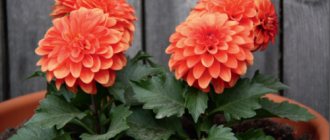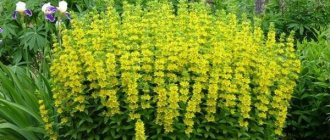Description and features
Pennisetum foxtail is a cereal plant. It is a planting with an erect stem up to 1 meter high and narrow long leaves. The apex is crowned with a spike-shaped inflorescence of beige, lilac, violet or red-brown color. During the period of dissolution it is highly decorative.
The inflorescence opens at the end of August or beginning of September. But even with the onset of frost, the plant retains its spectacular appearance. The color of the vegetative parts changes to yellow, but the integrity of the planting is maintained.
Additional Information. The literal translation of pennisetum from Latin is feather and bristle.
Description of the flower Pennisetum
The average height of dense thickets of pinnate bristles varies from 15 cm to almost 1.5 m. The plant consists of straight bare stems collected at the base of bright green half-meter narrow (about 5 mm wide) leaves, lush spike-shaped inflorescences of various colors with many fluffy bristles . The bush is popularly called “fountain grass” for its growth form. The perennial flowering continues from the beginning of July through almost the entire month of September. An important feature of pennisetum is its high resistance to all harmful insects and various diseases. Plants almost never suffer from such problems.
Growing seedlings
When planting hardened young bushes in a flowerbed, the development of pennisetum will begin earlier than when seeds were sown in open ground.
Deadlines
To plant pennisetum bushes in open ground, the seeds are sown in early April. Then the seedlings will have time to grow and become stronger before being planted in the ground. Young bushes are planted on the site in May.
Soil preparation
To grow pennisetum foxtail with seeds, loose soil is used to make it easier for the seedlings to develop. You can prepare the substrate yourself from a mixture of garden soil, peat and sand, or purchase soil for seedlings at a flower shop.
How to plant
Seeds need to be planted in separate small containers, since the bushes take a long time to take root after transplantation. To do this, you can take 200-gram plastic cups or peat pots. When using peat pots, planting on the site is done without removing the earthen clod. Seeds spilled on the surface are buried 2-3 millimeters.
Watering
Seeds are planted in moist soil. When the top layer dries out a little, it needs to be moistened with a spray bottle. Before watering, the water settles for at least a day.
Temperature and light conditions
Pots with seedlings are placed in a warm room that is well lit by the sun. If the growing region is northern, then the containers are covered with film or glass and illuminated with phytolamps.
Ventilation
The mini-greenhouse needs to be ventilated every day, while removing condensation from the glass. If this is not done, pathogenic microorganisms that harm the crops may appear inside the containers. When sprouts appear, the cover is removed.
How to plant pennisetum correctly
Pennisetum is replanted in the spring. Using a rope, you need to outline the shape of the flowerbed. A flowerbed with blurry edges looks very nice. Remove the soil from the flower bed.
Attention! If the terrain is suitable, some varieties can propagate by self-sowing. Therefore, you need to remove excess shoots in the fall.
Ambulance! There are not so many pests and diseases that affect pennisetum. But over time, the old bushes begin to die. The middle goes bad first. Therefore, it is necessary to dig up the bush, cut out the middle and destroy it. After this, only the strong outer parts should be planted.
Planting in open ground
Bushes grown in a warm room are planted in the ground after the onset of heat. To make them adapt faster, they are hardened 2 weeks before planting by exposing them to the air for half an hour.
See also
Planting and caring for Ixia in open ground, cultivation featuresRead
When to plant
Pennisetum foxtail is planted in open ground after the threat of frost has passed. In the southern regions this may be the end of April, in the northern regions - mid-May. By this time, the seedlings usually reach a height of 10-15 centimeters.
Selecting a location
In nature, pennisetum grows in hot climates, so choose a planting site that is well lit by the sun. The plant does not make great demands on the composition of the soil, the main thing is that it is not too moist.
Constant exposure of roots to moisture contributes to their infection by fungus.
Planting scheme
Since pennisetum is capable of growing strongly, the distance between bushes is maintained in the range of 50-90 centimeters. Dense planting is needed if the plant needs to be used as a hedge. The depth of the planting hole is determined so that the seedlings have enough space to develop roots.
Advice! If the plant is not planned to spread throughout the area, the planting area is fenced with slate, digging it to a depth of 50 centimeters.
Care
Caring for Pennisetum foxtail does not take much time and effort from the gardener during the season.
Watering
It is necessary to moisten the soil only if there is insufficient natural precipitation. In hot, dry summers, Pennisetum foxtail is watered once a week.
Loosening and weeding
While the bushes are small, the soil around them needs to be constantly loosened. During this procedure, air is supplied to the roots and they develop better. During this same period, weeding is necessary, otherwise the weeds will take away sunlight and moisture from the young bushes.
Top dressing
Pennisetum foxtail, planted in fertile soil, does not need to be fed for the first years. Adult bushes are fertilized in the spring with organic matter, for example, humus or manure. In summer, they are watered once a month with complex mineral fertilizer.
Diseases and pests
Pennisetum is rarely subject to pest invasion and disease formation. In too dry summers, spider mites may appear, which are easily washed off with a stream of water. Young plants can be favored by aphids, which are removed with a soap solution.
Trimming
There is no need to trim the stems of Pennisetum foxtail for the winter for several reasons:
- Dead wood prevents excessive moisture from the roots.
- Keeps kidneys from freezing.
- The site looks decorative not only in summer, but also in winter.
Only damaged leaves need to be cut off for the winter. In spring, the entire above-ground part is completely cut off so that young stems can develop.
Mulching
In order to retain moisture in the area where roots grow during hot summers, the bushes are mulched with peat, tree bark, and sawdust. In addition, mulch will protect the soil layer from forming a crust after rain or watering.
Preparing for winter
Before the onset of frost, the tree trunk circle is additionally sprinkled with dry leaves and covered with a special flooring. Another necessary procedure is to water the roots abundantly, since if the ground around them is moist, they are less damaged by frost. To prevent tall stems from bending under the pressure of snow in winter, they are tied with rope.
Problems when growing pennisetum, diseases and pests
Although pennisetum is resistant to diseases and pests, cases of shrub death are not uncommon, so the plant is carefully monitored and problems are eliminated as they arise.
| Symptom | Cause | Elimination methods |
| The stem rots, the bush withers. | Watering too often. | Reduce moisture or stop it completely before the onset of drought. |
| The leaves turn yellow and fall off. | The soil is dry. | Watering is organized 2 times a week for a month, then the standard is restored if the shrub needs it. |
| The plant does not recover after wintering. | The winter is too cold. | The next time, pennisetum is grown in a pot or tub, which is moved indoors at the end of October for the whole winter until the beginning of May. |
| Dark spots on leaves. | Disease: rust. Excessive moisture. | Spray with fungicides. Replant the bush into new soil. |
| Small voids appear on the leaves and stem. Yellow or red spots appear, shoots die. | Shield. | They use a solution of soap and alcohol, fern tincture and chemicals such as Permethrin, Bi 58, Phosfamide, Methylmercaptophos. |
| Small green insects appear throughout the bush. The stems and leaves wither, the pennisetum dies. | Aphid. | Increase the frequency of watering, treat the flower with a soap solution or tincture of lemon zest. Special intestinal preparations (Intavir, Actofit) are best suited for pest control. |
| The plant is covered with a thin web, and orange circles are visible on the back of the leaf. | Spider mite. | Moisten the bush generously and cover it with polyethylene for several days. Treat with Neoron, Omite, Fitoverm for one month according to the instructions. |
| Small beige pests on leaves, inflorescences and stems. White coating and waxy deposits. | Mealybug. | Remove growths and affected parts of the plant. Treat the soil with an alcohol solution and remove parasites. Aktara, Mospilan, Aktellik, Calypso are excellent for wrestling. |
Reproduction
Pennisetum foxtail can be grown in the garden in 2 ways: by seeds and by dividing the bush.
Seeds
Pennisetum can be propagated by seeds by first planting them as seedlings in April, or by sowing them directly into the ground in May. When using the seedling method, peat pots are used, which then rot in the ground, providing additional nutrition for the bushes.
Pennisetum can reproduce by self-sowing, scattering its seeds far.
Dividing the bush
Reproduction by dividing the bush is done when the plant has grown too much and the stems have begun to become smaller because of this. To do this, the plant is dug up, divided, and each section is transplanted into a separate hole. Care is carried out in the same way as for adult plantings.
See also
Planting, growing and caring for marigolds in open groundRead
Note! You need to divide the bushes with a sharp, disinfected tool.
Reproduction by dividing the bush and planting
Growing pennisetum gray is quite easy to propagate by dividing the bush, as it grows quickly. To do this, in the spring, young shoots along with the rhizome should be separated from it and planted in the desired area. The landing site should be sunny and protected from strong winds. For planting, it is better to prepare holes in advance by organizing drainage from small stones at the bottom. If the soil has a high density, it should be thoroughly loosened.
Kinds
Of the many species, only a few are cultivated in gardens.
Foxtail
The height of the bushes varies between 40-100 centimeters. The color of the fluffy panicles is red-brown or purple. In autumn, foxtail pennisetum changes the color of the plates from green to yellow.
Oriental
The height range of the bushes is from 15 to 80 centimeters. Blooms in August with a pink-violet palette. As it grows, it forms extensive sods.
Shaggy
Plantings grow up to half a meter. The paniculate inflorescences are white-golden in color. Often grown as a container plant.
Simple
The tall plant produces erect stems. The spikelets are thin, elongated, and appear in June. In autumn they turn yellow-brown in color.
Gray
A powerful shrub grows up to 2 meters. It got its name for its wide bluish leaves. Spike-shaped large inflorescences are painted in burgundy-bronze shades.
Bristly
A very decorative type of tall pennisetum. Its entire ground part is colored pink-purple. Beautiful inflorescences are used in winter bouquets.
Beautiful flowers in the country - details about planting and care Pennisetum beautiful cereals
| Ripsalidopsis: home care and plant varieties Pennisetum, or as it is also called pinnately bristle, belongs to the Poaceae family. There are about 150 species in the genus. In nature, the distribution zone is the tropics and subtropics. Most of the species live in Africa and South America. These are perennial, rarely annual, grasses 30-120 cm high with erect stems, linear leaves and flowers collected in spike-shaped panicles. Almost all species in Russia are suitable for growing in southern regions with a mild climate. In climate zones 4-5, pennisetum grows in containers or as an annual. But there are several species that successfully overwinter with shelter. The most popular is pennisetum foxtail (P. alopecuroides), which grows naturally in East Asia and Australia. In our middle zone in zone 5, it overwinters well under cover with leaves or spruce branches. This perennial forms a bush 30-60 cm high with narrow linear leaves, green in summer and golden yellow in autumn. In August–September, spike-shaped panicles up to 100 cm high appear, first whitish and then pink or red-brown. It is better to grow not the species itself, but the most beautiful varieties, for example, Hameln - a shorter variety and blooms already in August. Compressum has red-brown inflorescences on peduncles up to 90 cm high. It has good winter hardiness. But the Japonicum variety as a perennial will grow only in areas with a mild climate. It has ears about 80 cm high with white tops. Pennisetum orientale (P. orientale) forms a dense bush about 30 cm high, which retains its summer gray-green hue even in autumn. In August, flower stalks up to 70 cm high with silver-pink spike-shaped panicles appear. As a perennial, it grows best in areas with a mild climate, although according to some data it successfully winters with shelter in climate zone 5. Pennisetum bristles (P. setaceum) forms a bush of gray-green leaves 40 to 70 cm high. Peduncles up to 120 cm high end in pink or purple panicles. Flowering from August to October. Varieties Rubrum, Purpureum, Cupreum have reddish-purple leaves. In the middle zone, this very beautiful species can only be grown as an annual. In the south of Russia it winters with shelter, so it does not tolerate negative temperatures. It is worth mentioning such a species as hairy pennisetum (villosum). Unfortunately, when grown in open ground in the middle zone, it may not even have time to bloom. A dense bush of leaves about 30 cm high, blooms with fluffy spike-shaped whitish panicles on peduncles up to 60 cm high. Flowering from August to October. The plant prefers sunny and warm places. The soil required is rich in humus and permeable. Pennisetum does not like sandy, dry places, although it is quite drought-resistant. Weeding, loosening, and moderate watering are required, especially during dry periods. It is advisable to feed perennials in May and June with complex mineral fertilizer. There is information that it is better to feed every three weeks. Peduncles with blooming flowers can be used to decorate winter bouquets. For winter, the leaves and stems of perennials should be trimmed. If necessary, cover the soil around the roots with leaves, brushwood or spruce branches. Pennisetum is propagated by seeds or by dividing the bush. Both are done in the spring. Seeds can be sown in open ground in May or in April for seedlings in pots, followed by planting in a permanent place at the end of May. The distance between seedlings should be 60-80 cm. Under favorable climatic conditions, self-seeding is possible. In this case, excess shoots must be removed in spring and autumn. After a few years, the middle of perennial bushes gradually begins to die. Such plants should be dug up, the middle cut out and only the strong outer parts planted. Cirrus bristle is also popularly called fountain grass for its appearance. Sometimes it is sold in stores under this name. These “fountains” look beautiful in joint plantings with autumn-flowering perennials such as casters and yarrow. Pennisetum goes well with other ornamental grasses and shrubs with beautiful autumn foliage. |
Popular varieties
Below are the most famous varieties that are in demand among gardeners.
Hamelin
This variety belongs to Pennisetum foliaceus. It has elongated spikelets that are light in color. The leaves are narrow and rough to the touch.
Red Head
The bush is spherical, from its base grows a large number of trunks with smoky purple spikelets. The leaves are narrow, long, and their color is gray-green.
Purple Baron
This is one of the varieties of pennisetum glaucous. The trunks and leaves are green with a purple tinge. The color of the long spikelets is ruby-purple, their ends are whitish.
Mowdry
Pennisetum foxtail cultivar Maudry is decorated with pink-purple spikelets. The leaves are light green, with purple splashes. The bush grows up to 90 centimeters.
Rubrum
All parts of the pennisetum of the bristly variety Rubrum are colored red-violet. As they develop, paniculate inflorescences create something like a fountain.
Viridescence
The dense leaves of this variety are green at the beginning of the growing season, then acquire a purple color. The panicles of the inflorescences of Pennisetum foxtail viridescens are black-purple, slightly arched. The height of the bush is 70 centimeters.
Ornamental
Pennisetum gray variety Ornamental grows to a height of 1 meter in height and 40 centimeters in width. It has wide, bluish-green leaves. Dense spikelets are purple.
Moudry
The basal rosette of pennisetum foxtail variety Mowdri consists of green leaves and pink-smoky spikelets. The inflorescences are large, fluffy, and densely cover the bush.
Hamelin
Pennisetum foxtail Hamelin consists of narrow green leaves that change color to yellow in the fall. The color of the spikelets is light cream or beige. Tolerates winter well.
Use in landscape design
Pennisetum foxtail is used on the site as follows:
- As a material that strengthens the soil on slopes.
- It is planted on the banks of reservoirs, forming a natural landscape.
- Serves as a background for low-growing flowering plants.
- Planted as a foreground for taller flowering shrubs.
- Used to create smooth transitions in flower beds.
- Planted singly against the background of a lawn.
- Grown in large flowerpots. For the winter, plants can be brought into a cool room.
Pennisetum foxtail goes well with the surrounding plantings; it looks impressive and is easy to care for. Gardeners fell in love with it for these qualities, using it in various compositions on their plots.
Decorative use of foxtail penissetum
Cirrus bristlecone is quite actively used by landscape designers in creating plant compositions, especially near bodies of water, where the bushes are the background for other flowers (cotulas, marigolds, etc.).
The grass is ideal for forming living borders and is an excellent frame for park paths.
Together with lavender, stone rose, gray fescue and other flowers, the plant is used to form rocky compositions. Summer cottages are decorated with different varieties of pinnate bristle, differing in shape and color.
Growing Penisetum foxtail does not require much effort. It easily gets used to a new place, grows quickly and does not need watering. Thanks to the density of the bushes and flowering almost throughout the summer, this representative of cereals is ideal for decorating summer cottages and park landscapes.











